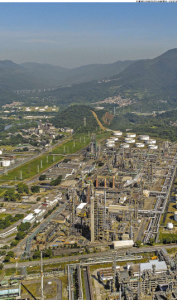Objective is to attract transformation industries

With the boost of the country’s economic indicators, Cubatão’s Polo intends to take advantage of its strategic advantages to attract new businesses this year.
According to the executive director of the Center for Integration and Development (Cide) and head of the Cubatão regional of the Center of Industries of the State of São Paulo (Ciesp), Valdir José Caobianco, the polo concentrates companies of the most representative segments and has a back- “Great interface” with the Port of Santos.
“We have the potential to grow even more and therefore be more competitive to compete with the external market”, he says.
To attract business, the industry entities, in partnership with the City Hall, launched last year the project Cubatão – The Factory of Opportunities.
The program consists of the work of the Industrial Condominium in the search for transformation industries for Cubatão. The representatives of Cide and Ciesp have already visited foreign chambers of commerce installed in Brazil to publicize the potential of the Polo.
The expectation is that these first contacts foster the installation of multinational units.
The pole has the trump of producing through five major industrial sectors: petrochemical, steel, chemical, fertilizers and logistics, as well as energy production and services.
Combustible
There are products consumed in the country that are made only in Cubatão, such as gasoline aviation, the use in airports and agribusiness aircraft. There are also calcined coke, ammonium nitrate (fertilizers) and anhydrous soda and benzene, the latter for the lubricants sector.
Caobianco points out that the pole still has room to receive new industries – there are 2.5 million square meters available.
The industrial condominium points out 11 reasons for a company to settle in Cubatão. For example, there is abundant power grid, with Henry Borden hydroelectric power plant and thermoelectric, and water.
In addition, there is a strategic location with a logistics network in the surroundings (port, railroad, highway and airports), many universities and diversified courses, connection with the largest consumer market in the country, and an already consolidated environmental sustainability program.
“We are convinced that the city is one of the strategic points for the resumption of the country’s growth”, concludes Caobianco.
More efficiency and less costs in Cubatão
The industrial condominium is an initiative of the Center for Integration and Development (Cide). The objective is to integrate the management of the Cubatão’s pole to, among several fronts, reduce costs in services and equipment common to all companies.
They are transportation, health and safety processes. With integrated and efficient operations, the pole will be able to maximize its advantages and fight its bottlenecks, gaining more competitiveness and attracting new business.
Cide brings together the presidents of the polo industries. The proposal for the creation of the condominium was created during the meeting of the industrial leaders at the Union of Chemical Industries for Industrial Purposes and Petroquimic in the State of São Paulo (Sinproquim).
In the event of the Brazilian Chemical Industry Association (Abiquim), last year, the condominium launched the Cubatão – The Factory of Opportunities program.
This year, the idea of the industrial leaders is to take advantage of the improvement of the economy, with increased confidence of the business, to attract manufacturing industries to Cubatão.
“It is time to take advantage of this phase and show that Cubatão is ready to receive new ventures”, says the director of Cide and Ciesp-Cubatão, Valdir Caobianco.
Labor
13 thousand jobs were maintained by Cubatão’s Pole companies in 2017;
123 million dollars in social charges were paid by the Cubatão Pole industries last year;
23 percent of Cubatão’s Pole jobs were maintained by the fertilizer sector in 2017.
Interview
Valdir José Caobianco – Executive Director of Cide and titular director of Ciesp de Cubatão

The improvement in economic indicators and the new government generated an expectation of more business in Cubatão. Check out the interview with the director of the entities, Cide and Ciesp, who present the polo industries, Valdir Caobianco.
What is the expectation of investments in the Polo in 2019?
The Center for Integration and Development (Cide), with the support of the Center of Industries of the State of São Paulo (Ciesp) – Cubatão Regional and City Hall, is promoting the program Cubatão – The Factory of Opportunities. The initiative aims to attract manufacturing industries to the largest industrial pole in Latin America in the raw material segment, which has infrastructure and fiscal incentives from the public power. With the installation of new industries, consequently, opportunities for employment and development of local commerce are generated.
What can the new government do to the competitiveness of companies?
The polo companies are competitive and work with the maximum results in conditions to compete with the outside, but they coexist with excessive interest, high energy and input costs, as well as the high tax burden. It still competes unevenly with the constant entry of imported products without logistical barriers and, in some cases, still with subsidized prices at the origin.
The new government is against incentives and exemptions. Is the polo industry ready to face an open market?
We have the potential to grow even more and consequently to be more competitive to compete with the foreign market. With the new government we will continue to act firmly through dialogue in all forums that Cide is present in the search for sustainable advances.
Source: A Tribuna Newspaper





















